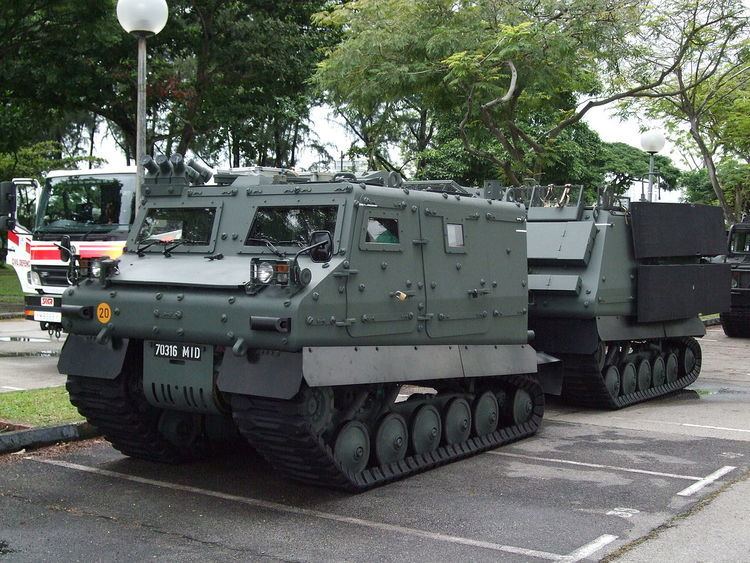Used by See users Weight 15 tonnes (33,100 lb) | ||
 | ||
Type amphibious armoured vehicle Manufacturer ST Kinetics, Otokar (under license) | ||
The Bronco All Terrain Tracked Carrier (ATTC) is a twin chassis multi-purpose articulated tracked carrier jointly developed by ST Kinetics and the Defence Science & Technology Agency (DSTA) for the Singapore Army. The variant which was in service with the UK armed forces is known as the Warthog.
Contents
Design
Designed to traverse difficult terrain, the Bronco has a ground pressure of 60 kPa and is fitted with heavy duty seamless rubber tracks and a running gear system for soft ground conditions and directional stability. Swimming operations require minimal preparation and it can achieve a swimming speed of 5 km/h. The Bronco's four-sprocket drive, fully articulated steering with optional differential lock provides for small turning radius manoeuvres and improved performance.
The Bronco has a load carrying capacity of up to 5 tonnes and is capable of a top speed of 60 km/h (37 mph) on the road and at least 25 km/h (16 mph) on cross-country terrain. An advantage the standard Bronco has over other western armoured personnel carriers is its relatively large interior, with seating for 16 including the driver.
Deployment
The Bronco has been fully operational with the Singapore Armed Forces for several years, with more than 600 on order and production still underway.
British service
In December 2008, ST Kinetics was awarded a £150 million contract by the British Ministry of Defence for over 100 Bronco All Terrain Tracked Carriers for use in Afghanistan. The vehicles, dubbed the Warthog in British service, will replace Vikings currently operating in southern Afghanistan by the British military, and are being procured as part of a £700 million package of Urgent Operational Requirements (UORs) recently announced by Defence Secretary John Hutton. Deliveries began in the third quarter of 2009, finished in 2010.
Four Warthog variants will be built under the contract – Troop Carrier, Ambulance, Command, and Repair & Recovery. The ambulance variant is capable of carrying casualties, medics and kit. Warthog's repair and recovery variant is fitted with a crane and winch, and has the capability to tow another 18-tonne Warthog vehicle back from the front line.
Once delivered to the UK, contractor Thales fits the vehicles according to MoD specifications with communications systems, specialist counter-measure equipment and extra protective armour at their facility in the former MoD depot at Llangennech near Llanelli, South Wales. The first vehicles arrived in service to Afghanistan in mid-2010.
In December 2010, British Army soldier – Lance Corporal William Reeks – survived an IED attack after the Warthog he was travelling in set off a 50 kg (110 lb) improvised explosive device. His family believes that the stronger armour of the Warthogs, which replaced less heavily fortified Viking armoured vehicles, helped save their son's life.
Warthog continued in British service in Helmand Province till the closure of Camp Bastion in 2015. It was crewed throughout its use in Afghanistan by soldiers exclusively from the Royal Armoured Corps. The last Warthog Group coming from C (the Duke of Edinburgh) Squadron, the Queen's Royal Hussars.
Jane's military guide has reported that British Warthog vehicles will be transformed to serve as transporter vehicles for Thales Watchkeeper UAV manned by 32nd Regiment Royal Artillery and 47th Regiment Royal Artillery under the Army 2020 concept. A March 2016 Jane's report stated the British army "dumped" the Warthog in October 2015, as "it was decided that the capability required from Warthog could be delivered by other vehicles".
Variants
Singapore has already deployed several variants of the Bronco, including ambulance, engineer, repair and recovery, load carrier, troop carrier and fuel resupply vehicles.
Mortar Tracked Carrier
A variant of the Bronco All-Terrain Tracked Carrier, the Mortar Tracked Carrier (MTC) is jointly developed by the SAF, DSTA and Singapore Technologies Kinetics. Operating on a 4 men crew, the MTC's primary weapon is the ST Kinetics 120mm Super Rapid Advanced Mortar System (SRAMS), the world's first recoiled mortar to incorporate a blast diffuser, greatly reducing the blast overpressure effect generated by mortars, thus allowing longer periods of firing without injuring the crew. The MTC has a built-in Automatic Fire Control System (AFCS) comprising a Fire Control Unit and an Inertial Navigation System, allowing it to conduct immediate deployment without conventional surveying methods. A hydro-pneumatic Recoil System reduces the overall recoil force, thus allowing minimal reinforcement of the original hull structure, and post-firing stabilising time. This increases the rate of firing with improved accuracy.
The AFCS is also equipped with a Mortar Platoon Management System (MPMS), which enables it to be networked via the Battlefield Management System (BMS).
